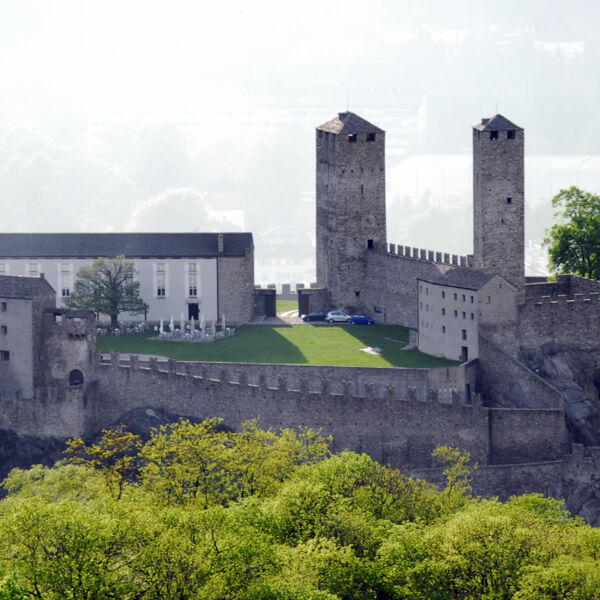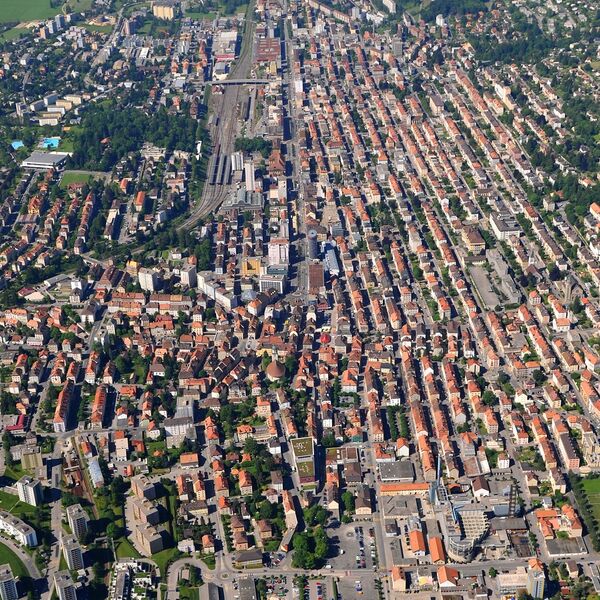Festung von Bellinzona
Die Festung von Bellinzona
Die Festung von Bellinzona bietet den Besuchern mittelalterliche Geschichte zum Anfassen.
Castelgrande
Die erste menschliche Besiedlung des Hügels von San Michele geht auf das Jahr 5500/5000 v. Chr. (Jungsteinzeit) zurück. Im 4. Jahrhundert n. Chr. entstand dann die erste archäologisch bestätigte Festung. Auch verschiedene Dokumente aus dem 6. Jahrhundert bestätigen das Bestehen einer Befestigungsanlage. Im 14. Jahrhundert tauchte erstmals der lateinische Name für Castelgrande, Castel Magnum, auf. Dies ist auch der heutige Name, selbst wenn die Burg während der eidgenössischen Besatzungszeit Castello di Uri (1630) oder Castello di Altdorf und im Jahr 1818 San Michele genannt wurde.
Der gegenwärtig sichtbare Gebäudekomplex geht auf verschiedene Epochen zurück: Die Bauten aus dem 13. Jahrhundert wurden 1473-1486 mit einer «mailändischen«» Phase überbaut, auf die Anfang des 17. Jahrhunderts Wiederherstellungsarbeiten und im 19. Jahrhundert mehrere grosse Eingriffe und Massnahmen folgten. Das heutige Aussehen ist das Resultat der letzten Restaurierungsarbeiten (1984-1991), die von dem Architekten Aurelio Galfetti geleitet wurden.
Die Zinnen-Ringmauer ist in 3 Abschnitte unterteilt. Von einem dieser Abschnitte aus erstrecken sich 2 Mauerausläufer direkt bis in die Stadt. Einst waren diese Befestigungsanlagen mit den vom Castello di Montebello bergab führenden Festungsmauern verbunden und dienten dazu, die Bevölkerung zu schützen.
Auf der anderen Seite schliesst sich an das Castelgrande die Wehrmauer «Murata» an, die zur Zeit der Visconti, der Herrscher des Herzogtums Mailand, bis zu den Ufern des Ticino reichte. Die gegen Ende des 14. Jahrhunderts erbaute Murata wurde zwischen 1486 und 1489 von den Sforza durch eine Brücke über den Fluss und einen mächtigen Turm, die Torretta, ausgebaut, die jedoch beide im Jahr 1515 von der «Buzza di Biasca» (Bergsturz von Biasca) zerstört wurden.
Burg Montebello
Vom Hügel Montebello aus, auf dem das zweite Castello von Bellinzona 90 Meter über der Stadt thront, blicken wir auf das Castelgrande hinunter.
Von hier aus verliefen die Mauern, die einst die Altstadt umfingen, bis hin zu den Mauern, die vom Hügel S. Michele hinunterführten. Teile dieser Ringmauer, die die nördliche und südliche Flanke der riesigen dreieckigen Festung beschützten, existieren auch heute noch.
Der älteste interne Mauerkern stammt aus dem 13./14. Jahrhundert. Er soll von den Rusca, einer reichen Kaufmannsfamilie aus Como, erbaut worden sein, die diesen Mauerkern auch unter der Herrschaft der Visconti noch bewahrte. Die äusseren Burghöfe mit ihren Türmen und dem Wallschild wurden im 14./15. Jahrhundert errichtet und verdanken ihre heutige Form den von den Ingenieuren der Sforza-Zeit Ende des 15. Jahrhunderts durchgeführten Arbeiten.
Ursprünglich hiess die Burg Castello Piccolo (1457-1472) oder Castello di Montebello. Unter der eidgenössischen Besatzung wurde sie auf Burg Schwyz und später, 1818, auf S. Martino umgetauft.
Gegen Ende des 18. Jahrhunderts kam die Burg in den Besitz der Familie Ghiringhelli. 1903 wurde sie aus Anlass der 100-jährigen Unabhängigkeit des Tessins vom Kanton erstanden und restauriert.
Im Inneren des Schlosses zeichnet der neue Ausstellungsrundgang Archeologia Montebello die Geschichte des mittelalterlichen Herrenhauses und die Restaurierungsarbeiten nach, die es charakterisiert haben, sowie die wichtigsten Etappen, die die Geschichte der Menschheit geprägt haben, die dank der in unserem Gebiet ans Licht gebrachten archäologischen Funde rekonstruiert wurde.
Burg Sasso Corbaro
Der Name dieser Festung basiert auf ihrer geografischen Lage: Das Castello befindet sich auf einem felsigen Vorsprung, der so dunkel ist wie die Federn der Raben (die dialektale Bezeichnung für «Rabe» ist «corbatt»). Es handelt sich hierbei um ein typisches Sforza-Schloss, dessen Mauerwerke auf geometrische Grundformen beschränkt sind. Neben dem viereckigen Innenhof, der von hohen Mauern umgeben ist, gibt es auch einen massiven Hauptturm sowie den Beobachtungsturm.
Das Castello di Sasso Corbaro ist die einzige der 3 Burgen mit einem präzisen Erbauungsdatum: Es war das Jahr 1479. Die Festung wurde in etwas mehr als 6 Monaten vom Architekten und Militäringenieur Benedetto Ferrini errichtet und war so konzipiert, dass sie die Verteidigungslinie vervollständigte, die den Durchzug der Eidgenossen in Richtung Mailand verhindern sollte.
Unter der eidgenössischen Besatzung hiess die Burg Castello di Unterwalden, ab dem Jahr 1818 war auch die Bezeichnung Castello di Santa Barbara geläufig.
1870 überliess der Kanton Tessin die Ruine einer privaten Gesellschaft, die hier ein Hotel errichten wollte. Später wurde die Burg an einige Bellenzer Familien verpachtet, die sie zu einer Sommerresidenz umgestalteten.
Durch die von der Architektin Paola Piffaretti durchgeführten Restaurierungsmassnahmen (2004-2006) kommt das Potenzial der Burg mit all ihren Besichtigungsmöglichkeiten heute voll zur Geltung, wobei sich auch ein neu angelegtes Netz aus Wanderwegen sehr dezent in die natürliche Umgebung einfügt.
In der Burg werden heute auch temporäre nationale und internationale Messen und Ausstellungen zu verschiedenen Themen durchgeführt.








